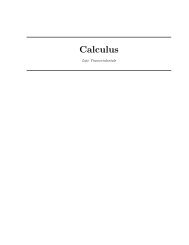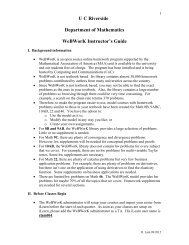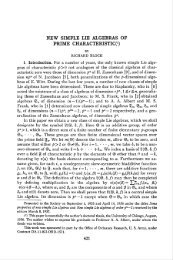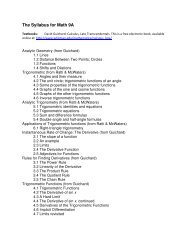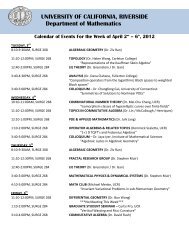Mining Big Data - Department of Mathematics - University of ...
Mining Big Data - Department of Mathematics - University of ...
Mining Big Data - Department of Mathematics - University of ...
Create successful ePaper yourself
Turn your PDF publications into a flip-book with our unique Google optimized e-Paper software.
uses particle accelerators and detectors tore-create the first moments after the <strong>Big</strong>Bang, 13.7 billion years ago. Theseinstruments allow scientists to study theparticles that form the very foundation <strong>of</strong>the universe.That alone is mind-boggling. Butthere’s more.To accomplish this work, theaccelerator hurls two beams <strong>of</strong> particles inopposite directions at almost the speed <strong>of</strong>light. The magnets continually narrow thefield through which the particles pass,forcing them to collide, as many as 600million times per second! (Yes, you readcorrectly.) This feat is something likefiring two needles from 10 kilometersapart so that they connect in the middle.If CERN is a place <strong>of</strong> precision, it isalso a place <strong>of</strong> extremes.Extremes <strong>of</strong> size and scope. The LargeHadron Collider (LHC) is a26.7-kilometer ring <strong>of</strong> superconductingmagnets buried 100 meters underground.It holds 9,300 magnets, many 50-70 feetlong. Yet the circuitry inside is as fine andprecise as the inside <strong>of</strong> a smart phone.And the particles it produces are thetiniest in the universe.We visited the hall where theseleviathans are constructed and tested. Butparts are built elsewhere and shipped toCERN. UCR scientists played a pivotalrole in the assembly and testing <strong>of</strong> themuon detectors, a critical part <strong>of</strong> theinstrumentation.Extremes <strong>of</strong> temperature. At fulloperation, the magnets are lowered tominus 456 degrees Fahrenheit. (Yes, I saidminus.) Yet, when two beams <strong>of</strong> lead ionscollide, they generate temperatures100,000 times hotter than the sun.Extremes <strong>of</strong> appearance. Some <strong>of</strong>CERN’s buildings date back to itsfounding in 1954 (the same year as UCR),and have seen better days. But theconfigurations formed by the LHC are sobeautiful and multi-hued that CERN hasits own artist-in-residence. Photographerscome from all over to capture the images.And did I mention the computers? Wetoured two vibrant control rooms, eachequipped with hundreds <strong>of</strong> monitors. Westood, fascinated, in front <strong>of</strong> a monitorshowing more than 200,000 data transferstaking place at that very moment – anilluminated globe with lighted strands <strong>of</strong>color running from locations all over theworld to CERN’s computer grid.CERN is a model for internationalresearch collaboration. With 20 memberstates, CERN has nearly 10,000 visitingscientists, representing 608 universitiesacross 133 countries. Currently amongthem are six UCR faculty members (seebelow), three postdoctoral researchers and14 graduate students.Distinguished Pr<strong>of</strong>essor <strong>of</strong> Physics GailHanson led us on the tour. Later we metwith her research team: one graduatestudent, three postdoctoral researchersand a recent Ph.D. student. They areamong many teams worldwide engaged inthe search for the elusive Higgs boson, theelementary particle that is believed to giveother particles mass – which they lackedin the first moments after the <strong>Big</strong> Bang. Itis the final piece <strong>of</strong> the puzzle that formsthe standard model <strong>of</strong> physics.Those at CERN are so confident theywill find the Higgs boson within the nextyear that they are postponing a scheduledshutdown until the discovery is made.The excitement is palpable. And UCR ispart <strong>of</strong> the global research team. If theyfind it soon, I can say, “I was there!” Andif it takes longer, maybe I’ll have time togo back to graduate school.The UCR Physicistsat CERNRobert Clare – Researches electroweak andHiggs physics. His team helped commissionthe Compact Muon Solenoid facility atCERN, and he is deputy chair <strong>of</strong> the U.S.contingent at the solenoid facility.John Ellison – Works on searches for newparticles, including supersymmetric particlesand heavy neutrinos. He’s also helpingdesign a new pixel and tracking system to beinstalled when the Large Hadron Collider isupgraded, starting around 2018.J. William Gary – A member <strong>of</strong> the CompactMuon Solenoid collaboration, focusing onsearches for supersymmetry in events withbottom quarks, and contributing to operation<strong>of</strong> the hadronic calorimeter.Gail Hanson – Involved in the search for theHiggs boson and physics beyond thestandard model. She works on the CompactMuon Solenoid Silicon Tracker, as well as onresearch and development toward a futureneutrino factory and muon collider, probablyat Fermilab.Owen Long – Works on physics beyond thestandard model. As part <strong>of</strong> the CompactMuon Solenoid collaboration, he is searchingfor signs <strong>of</strong> supersymmetry.Stephen Wimpenny – Involved in LargeHadron Collider physics. He is collaboratingon the Compact Muon Solenoid experiment,with a focus on top quark physics.The Cast <strong>of</strong> ParticlesQuarks – elementary particles (point-like,with no internal structure) found insideprotons and other hadronsHadrons – any particle made from quarksGluons – force carrier particles that bindquarks inside hadronsTop quark – the heaviest quark, and the heaviestby far <strong>of</strong> all known elementary particlesBottom quark – the second-heaviest quark,distinguished by a long lifetimeHiggs boson – a hypothetical particle used toexplain how particles acquire mass. It is theonly Standard Model particle that has notyet been observed.Muons – heavier versions <strong>of</strong> electronsNeutrinos – neutral, nearly massless particlesthat interact only via weak nuclear forcesand so are almost invisibleUCR UCR Spring 2012 | 25 | 25



